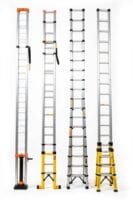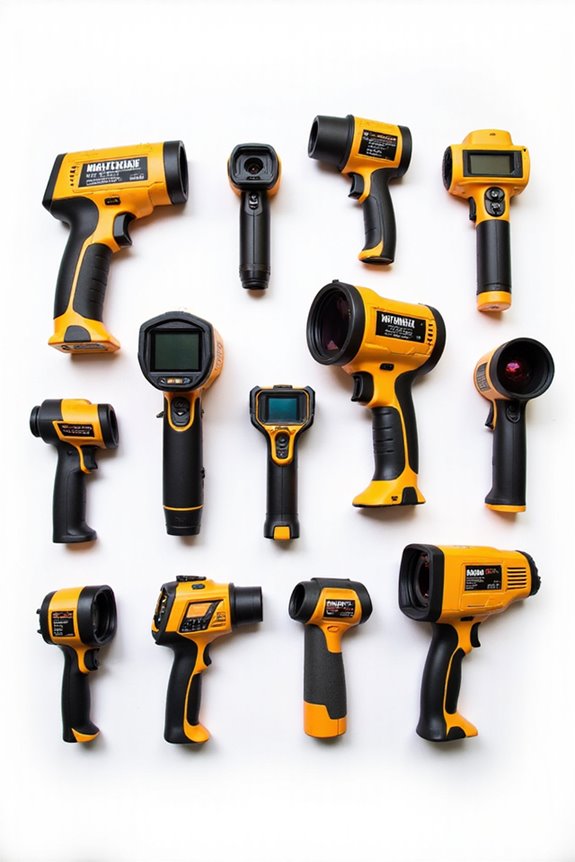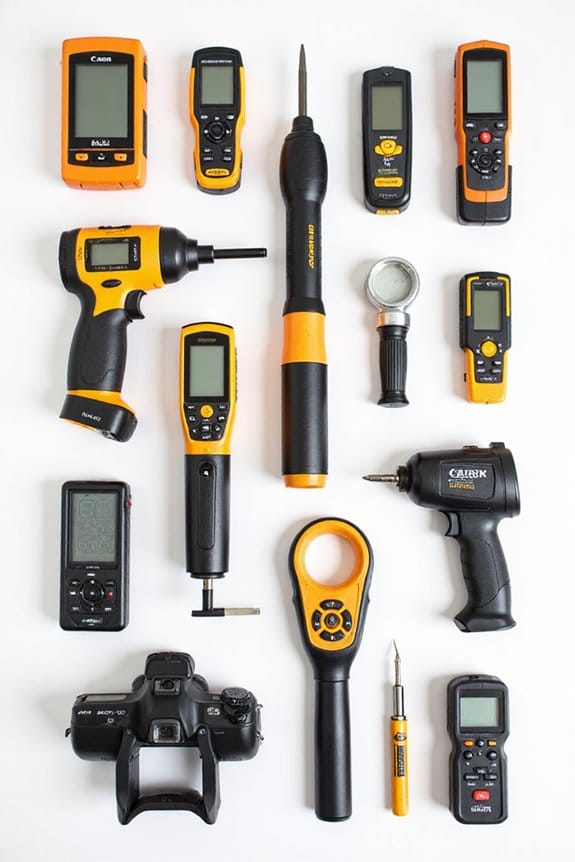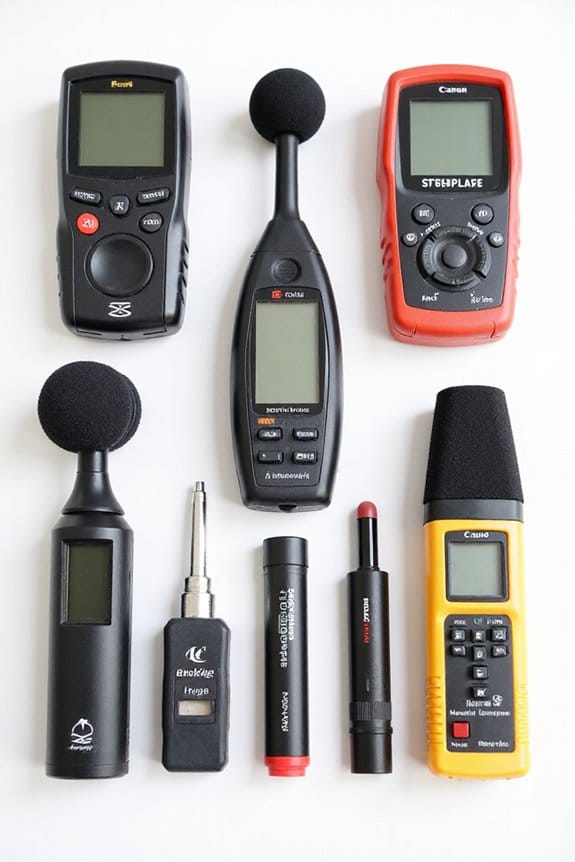As an Amazon Associate, we earn from qualifying purchases. Some links may be affiliate links at no extra cost to you. Although our opinions are based on curated research, we haven't used these products. Articles generated with AI.
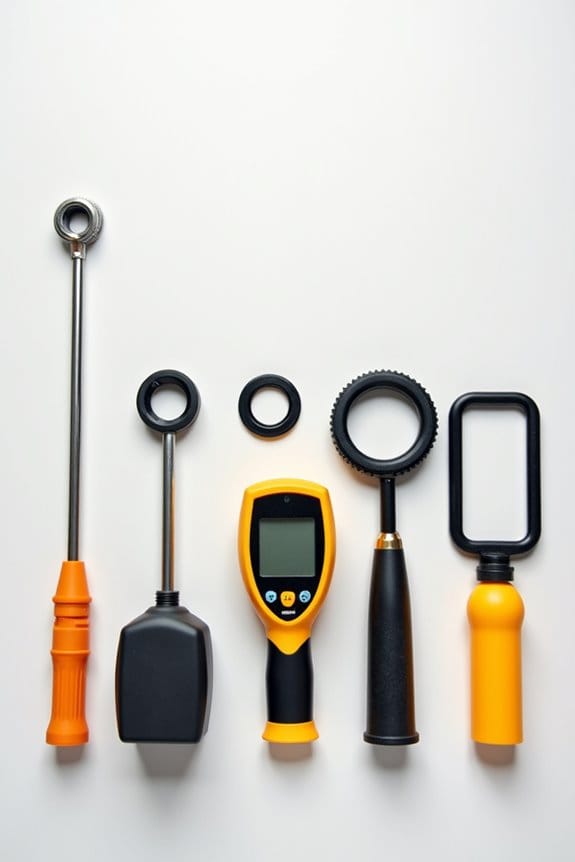
5 Best Ways to Check for Gas Leaks – Stay Safe and Secure in Your Home
If you want to check for gas leaks and keep your home safe, here are five great methods. First, use the PT520A Natural Gas Detector for its gooseneck flexibility. Second, the TopTes PT177 is pocket-sized for easy portability. Third, try the PT199 if you need a compact option with alarms. Fourth, the Explosion-Proof Alarm offers durability and loud alerts. Finally, don’t forget to take into account key factors like sensitivity and battery life to guarantee you’ve got the right tool. Stick around to discover more details!
Key Takeaways
- Use a gas leak detector to identify methane, propane, and LPG quickly and reliably in your home environment.
- Apply soapy water to joints and connections; bubbling indicates a gas leak that needs immediate attention.
- Pay attention to unusual smells; natural gas often has a distinct odor resembling rotten eggs, signaling a potential leak.
- Regularly inspect appliances and their connections for signs of wear or damage that could lead to gas leaks.
- Ensure proper ventilation and check for unusual sounds near gas lines or appliances that may indicate a leak.
PT520A Natural Gas Detector with 17-Inch Gooseneck
PT520A Natural Gas Detector, Gas Leak Detector with 17-Inch Gooseneck, Locating The Source Like...
- Effective Gas Leak Detector: The TOPTES PT520A natural gas detector detects leaks of methane, propane, natural gas, LPG, butane, and more in tight spaces.
- Flexible Probe: The 17-inch gooseneck allows easy access to hard-to-reach areas like pipelines, storage tanks, gas fireplaces, and basements, ideal for both indoor and...
- Visual and Audible Alarm: PT520A responds in 0.5 seconds, with 7 colored bars and a 75dB alarm that increase with gas concentration. Detection range: 50-10,000 ppm...
If you’re looking for an effective way to check for gas leaks in those tricky spots around your home, the PT520A Natural Gas Detector with its 17-inch gooseneck is your best buddy. This handy tool can detect methane, propane, and LPG in tight spaces, making it perfect for checking behind appliances or near gas lines.
- Quick detection: It responds in just 0.5 seconds.
- Easy to use: With its non-slip grip, you’ll feel confident while inspecting.
- Alerts: It features visual and audible notifications, so you won’t miss any leaks.
At around $40, it’s an affordable safety investment you won’t regret!
Best For: Homeowners with gas appliances or those needing to check for gas leaks in hard-to-reach areas.
Pros:
- Quick detection with a response time of just 0.5 seconds.
- User-friendly design with a non-slip grip for comfortable handling.
- Visual and audible alerts ensure leaks are easily noticed.
Cons:
- Not suitable as a professional gas detection tool in emergencies; consult professionals if strong odors are present.
- Some users report delays during startup and automatic shut-off functions.
- Limited effectiveness in confined spaces without proper ventilation.
TopTes PT177 Natural Gas Detector
Natural Gas Detector, TopTes PT177 Gas Leak Detector with Audible & Visual Alarm, Portable Gas...
- Combustible Gas Leak Detector: PT177 is a useful little tool that helps every household with gas appliances to quickly and easily pinpoint the leakage of combustible gas...
- Visual and Audible Alarms: PT177 gas detector requires a 30-second auto-calibration after powering on and can detect gas and trigger an alarm within 0.5 to 3 seconds....
- Pocket sized with a pocket clip that allows you to carry it in your shirt pocket. The included storage bag makes the natural gas detector easy to store. It is a...
The TopTes PT177 Natural Gas Detector is a pocket-sized powerhouse designed for anyone concerned about gas leaks in their home or while enjoying outdoor activities such as barbecuing. This handy detector detects various gases, including propane and methane, making it versatile. Here’s why you’ll love it:
- Quick Detection: It alarms in just 0.5 to 3 seconds—talk about speedy!
- User-Friendly: Battery indicator and auto shut-off after 5 minutes keep things simple.
- Portable: Weighing just 0.12 kg, you can clip it wherever you go.
With great reviews and a three-year warranty, you can trust this sleek device to keep you safe.
Best For: Anyone seeking a reliable and portable solution for detecting gas leaks in homes, RVs, or during outdoor cooking activities.
Pros:
- Quick detection with alarm response time of 0.5 to 3 seconds.
- User-friendly design featuring a low battery indicator and auto shut-off function.
- Compact and lightweight, making it easy to carry and store.
Cons:
- Requires battery replacements, which may add extra cost over time.
- Limited to detecting specific gases; may not identify all potential hazards.
- May have a learning curve for first-time users to understand the alarm system fully.
PT520A Natural Gas Detector with 17-Inch Gooseneck
PT520A Natural Gas Detector, Gas Leak Detector with 17-Inch Gooseneck, Locating The Source Like...
- Effective Gas Leak Detector: The TOPTES PT520A natural gas detector detects leaks of methane, propane, natural gas, LPG, butane, and more in tight spaces.
- Flexible Probe: The 17-inch gooseneck allows easy access to hard-to-reach areas like pipelines, storage tanks, gas fireplaces, and basements, ideal for both indoor and...
- Visual and Audible Alarm: PT520A responds in 0.5 seconds, with 7 colored bars and a 75dB alarm that increase with gas concentration. Detection range: 50-10,000 ppm...
Need to sniff out gas leaks in tricky spots? The PT520A Natural Gas Detector features a flexible 17-inch gooseneck that gets into tight areas like behind appliances and gas lines. Here’s what you’ll love about it:
- Quick Detection: It responds in just 0.5 seconds, detecting methane and propane from 50-10,000 ppm.
- User-Friendly: With visual alerts and a loud 75dB alarm, you’ll never miss a leak.
- Smart Design: Auto power-off and a mute button add convenience.
At around $40, it’s a smart investment for your home safety. Just remember, it’s not a substitute for professionals during serious leaks!
Best For: Homeowners and DIY enthusiasts looking for an affordable and effective solution to detect gas leaks in hard-to-reach areas.
Pros:
- Quick Detection: Responds in just 0.5 seconds with a wide detection range of 50-10,000 ppm.
- User-Friendly Alerts: Visual indicators and a loud 75dB alarm ensure that gas leaks are easily noticeable.
- Flexible Design: The 17-inch gooseneck allows for easy access to tight spaces and behind appliances.
Cons:
- Not for Emergency Use: Should not replace professional gas detection services in serious situations.
- Calibration Required: Users must calibrate in well-ventilated areas for accurate readings.
- Startup Delays: Some users reported delays during startup and automatic shut-off features.
PT199 Natural Gas Leak Detector with Audible & Visual Alarm
PT199 Natural Gas Leak Detector with Audible & Visual Alarm, Portable Gas Sniffer to Locate...
- Combustible Gas Leak Detector: The TopTes PT199 detects natural gas, methane, propane, butane, LPG, and more, pinpointing leaks to reduce the risk of explosion, keeping...
- Visual and Audio Gas Alarm: Visual and audio alarms trigger within 0.5 seconds of gas detection. The alarm intensifies with gas concentration, and the LCD screen turns...
- Batteries Included and Easy to Use: The TopTes PT199 includes 2x AAA batteries and is ready after a 30-second warm-up. The low battery indicator activates below 2.4V, and...
For anyone looking to safeguard their home from potential gas leaks, the PT199 Natural Gas Leak Detector stands out as a reliable companion. Here’s why you’ll love it:
- Portable Design: Its compact, pocket-sized, orange body makes it easy to carry and spot.
- Quick Setup: After a 30-second warm-up, you’re good to go!
- Fast Detection: It alerts you with audible and visual alarms within 0.5 seconds of detecting gas.
- Versatile Use: Perfect for RV owners and DIYers, ensuring you’re never in the dark about gas leaks.
Best For: Homeowners, DIYers, and RV owners seeking a reliable solution to detect gas leaks and ensure safety.
Pros:
- Portable Design: Compact and easy to carry with a bright orange color for visibility.
- Fast Response Time: Audible and visual alarms activate within 0.5 seconds of gas detection.
- User-Friendly: Quick setup with a 30-second warm-up period, making it simple for anyone to use.
Cons:
- Detection Distance: Limited detection range of 1-5 cm may require close proximity to the gas source.
- Battery Dependency: Operates on AAA batteries, which require periodic replacement.
- Limited to Specific Gases: Primarily detects methane, propane, butane, and LPG, not covering all gas types.
Explosion-Proof Natural Gas Detector Alarm
Explosion-Proof Natural Gas Detector Alarm - Ultra-Sensitive CH4/Propane Gas Leak Alert with 85dB...
- 【10-Second Military-Grade Detection】MEMS sensor array detects CH4/propane leaks at 8% LEL (±3% accuracy) within 10 seconds. Smart Auto-Calibration with environmental...
- 【3D alarm Matrix with 85dB Pulsed Siren】360° warning system: 85dB aviation-grade alarm (30m range) + 4-LED strobe array (120° coverage). Four-color smart indicator:...
- 【10-Year Aerospace-Grade Durability】Explosion-proof ABS+PC composite passes 2000hr aging tests.Self-diagnosis chip monitors component health, with yellow LED warning...
Looking for a reliable way to guarantee safety in your home or RV? The Explosion-Proof Natural Gas Detector Alarm could be your best choice. Here’s why:
- Quick Detection: It detects CH4 and propane leaks in just 10 seconds.
- Loud Alarm: An 85dB alarm alerts you from up to 30 meters away.
- Compact Design: Its portable size fits anywhere, making installation a breeze.
- Long-lasting: With a 10-year warranty, you’ll receive a warning when it’s time for a replacement.
Just remember, while it’s solid, some users are cautious about the sensitivity. Stay safe out there!
Best For: This product is best for homeowners and RV enthusiasts seeking a reliable and portable solution for detecting natural gas and propane leaks.
Pros:
- Battery-operated for flexible placement without the need for outlets.
- Compact design makes it easy to install and aesthetically pleasing.
- High sensitivity at 8% LEL enhances safety compared to standard requirements.
Cons:
- Reliance on batteries may raise concerns about consistent operation.
- Some users have reported alarm failures during testing.
- Lack of visible independent certification seals may prompt questions about reliability.
Factors to Consider When Choosing to Check Gas Leaks

When you’re picking a method to check for gas leaks, there are a few key factors to keep in mind. You want to think about detection range, alarm features, and even how portable the device is—size matters! Plus, don’t forget battery life and accuracy; after all, no one wants a false alarm when it’s snack time!
Detection Range Requirements
Choosing the right gas leak detector can feel overwhelming, especially with so many options available. Here’s what you need to take into account regarding detection range:
- Detection Sensitivity: Look for detectors with ranges between 50 to 10,000 ppm, making sure they sense both small and large leaks.
- Distance: Most detectors work best 1 to 5 cm from the gas source. This is perfect for those tricky spots behind appliances.
- Space Size: Longer ranges are ideal for larger areas. For tight spaces, shorter-range models are your go-to.
- Calibration: Make certain your chosen device can calibrate in well-ventilated areas for accurate readings.
Alarm System Features
After narrowing down your gas leak detector based on detection range requirements, it’s time to contemplate another vital aspect: the alarm system features. Here’s what you should consider:
- Dual-alert systems: Look for detectors that offer both visual and audible alarms to boost safety in any setting.
- Loudness of the alarm: Choose one with at least 75 dB so you can hear it even over a lively family gathering.
- Response time: A quality detector should activate within 0.5 to 3 seconds. Quick action can save your day!
- Alarm intensification: Some systems increase alarm intensity with rising gas levels—smart, right?
- LCD screens: Detectors with color-changing displays help you grasp the severity at a glance. Happy detecting!
Portability and Size
Although it might not seem like a top priority, portability and size play a significant role when you’re selecting a gas leak detector. Here’s why these factors matter:
- Easy Carrying: Pocket-sized models with clips let you take them anywhere, making inspections a breeze.
- Lightweight: Compact detectors weigh less than 5 ounces, perfect for homes, RVs, or outdoor adventures.
- Access Tight Spaces: Look for longer probes or goosenecks (about 17 inches) to reach behind appliances or into cramped areas.
- Battery-Powered: Models that run on batteries don’t tether you to power outlets, offering flexible inspection options.
- Quick Setup: Many portable detectors require just a 30-second warm-up, so you can start evaluating right away. Safety first!
Battery Life Considerations
When it comes to gas leak detectors, battery life can make all the difference—especially if you’re relying on your device for safety. Here are key factors to bear in mind:
- Battery Longevity: Shorter battery life may leave you in the lurch when it matters most. Always check the estimated battery life!
- Battery Type: Many detectors use standard batteries like AAA. They’re easy to replace, which is a bonus.
- Low Battery Indicators: Look for detectors that alert you when the battery gets low, typically around 2.4 volts. This feature can save the day.
- Auto Shut-off: A handy feature that conserves battery by turning off the device after a period of inactivity.
Regularly replacing batteries guarantees your detector’s ready to protect you against gas leaks. Stay safe!
Accuracy and Calibration
Choosing the right gas leak detector hinges on two key elements: accuracy and calibration. Here are a few things to take into account:
- Accuracy: A reliable detector finds even tiny leaks, essential for safety. You want one that can detect gas concentrations as low as 50 ppm.
- Calibration: Many detectors need a quick auto-calibration upon powering up. This guarantees they’re ready to provide dependable data, so don’t skip this step!
- Detection Range: Different devices vary widely in their effectiveness. Make sure to pick one that suits your specific needs.
- Response Time: Look for quick alarms—within 0.5 to 3 seconds—so you can act fast.
User-Friendly Design
Now that you’ve got a solid understanding of accuracy and calibration in gas leak detectors, let’s focus on how user-friendly design can make your experience even better. Here are a few key features to evaluate:
- Intuitive Controls: Look for detectors with easy-to-use buttons; simplicity is key!
- Easy-to-Read Displays: A clear screen helps you quickly understand what you need.
- Battery Indicators: These alert you when it’s time to recharge, ensuring your detector’s always ready.
- Auto Shut-off: This feature saves battery life by switching off after inactivity—no more surprises.
- Ergonomic Design: Non-slip grips and flexible goosenecks make inspecting tight spots a breeze!
Lastly, quick warm-up times and rapid responses (in just 0.5 seconds) can really save you time!
Frequently Asked Questions
How Often Should I Check for Gas Leaks at Home?
Imagine the comforting warmth of your home, but remember, even a small gas leak can turn cozy into chaotic. You should check for gas leaks at least once a year. Follow these steps:
- Smell for any unusual odors—like rotten eggs.
- Listen for hissing sounds.
- Use soapy water on connections; bubbles mean trouble.
If you’re unsure, a professional inspection’s a smart move. Better safe than sorry, right?
What Are Common Signs of a Gas Leak?
When it comes to gas leaks, you should look out for these common signs:
- Smell: You’ll often notice a sulfur-like odor—it’s hard to miss!
- Sound: Listen for a hissing noise near gas lines; it’s not your imagination.
- Visual signs: If you see dying vegetation around your gas line, that’s a red flag.
If you notice any of these, don’t hesitate—better safe than sorry! Call a professional immediately.
Are Gas Leak Detectors Necessary for Every Home?
Are gas leak detectors necessary for every home? The short answer? Yes! Here’s why:
- Detection: They sense leaks faster than you can say “Whoops!”
- Safety: They keep you and your loved ones safe.
- Peace of Mind: You sleep better knowing your home is secure.
While you might not think you need one, it’s a small investment for a huge sense of security. Trust me, it’s worth it!
Can I Smell a Gas Leak Without a Detector?
Ah, the good old days when your nose could sniff out danger! Yes, you can smell a gas leak without a detector; natural gas is added with a distinctive odor. Here’s what you should do:
- Stay vigilant! If you detect a sulfuric, rotten egg smell, it could be serious.
- Don’t ignore sounds like hissing or whistling, either; they’re not just your imagination.
- Evacuate and call for help. Better safe than sorry!
Stay alert!
What Should I Do if I Suspect a Gas Leak?
If you suspect a gas leak, don’t panic! Follow these steps:
- Evacuate – Leave the area immediately, bringing everyone (including pets) with you.
- Avoid igniting anything – Don’t use your phone or flip switches.
- Call for help – From a safe location, contact your gas company or emergency services.
- Wait for professionals to check it out before re-entering. Safety first—your house will still be there when you get back!



